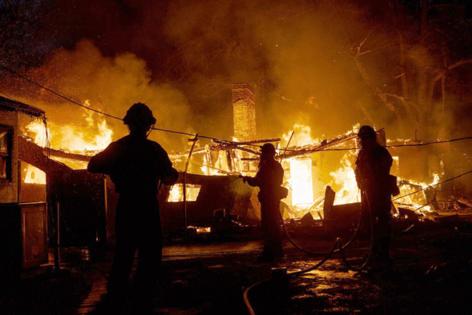Hundreds of deaths may be linked to the Eaton and Palisades fires, new study suggests
Published in News & Features
LOS ANGELES — By all accounts, the January firestorms that decimated thousands of homes and killed 31 people in Los Angeles County were the most devastating in the region’s history.
But new research argues that the Eaton and Palisades fires may have been far more deadly than what’s reflected in coroner reports.
A research letter published Wednesday in the Journal of the American Medical Association estimates the county experienced 440 more deaths than typically expected between Jan. 5 and Feb. 1 — a period that began just days before the fires exploded. This higher number of deaths, the study notes, likely reflect such health-damaging influences as increased exposure to poor air quality, or delays and interruptions in health services caused by the fires.
While the immediate effects of wildfire and other climate-driven disasters are starkly apparent in hard-hit communities, the lingering consequences can be challenging to quantify. Toxic smoke exposure and environmental damage stemming from wildfires can linger months, and even years, after the flames are extinguished.
“Attributing deaths properly to a wildfire is just almost an impossible task,” said Andrew Stokes, an associate professor at Boston University and a mortality demographer who co-authored the research letter. “The research highlights the need for these types of modeling efforts to really get at the true burden of these disasters.”
To generate their findings, study authors compared recorded deaths in Los Angeles County from Jan. 5 to Feb. 1 to those tallied during the same period in 2018, 2019 and 2024. (They excluded the years 2020 through 2023 when fatalities were significantly higher due to COVID.)
According to their models, 6,371 deaths were recorded during the nearly month-long period during the fires compared to 5,931 deaths that were expected based on data from past years.
Official death counts often rely on easily identifiable causes, including burns and smoke inhalation. But those numbers sometimes fail to capture the complete toll of a natural disaster.
According to the county medical examiner, 19 people died in the Eaton fire and 12 people were killed in the Palisades fire. Many who perished were eventually found among the remnants of their destroyed properties.
But the study argues that the actual deaths attributable to the fires were more than 14 times the official count.
“The differences are staggering,” Stokes said.
Heat waves, hurricanes and other disasters have been the subject of similar research, but wildfires can be challenging to study when they erupt in rural, sparsely populated regions. Since the Palisades and Eaton fires occurred in “one of the most densely populated areas of the nation, it was possible using national mortality statistics to establish a reliable baseline trend to estimate excess deaths,” Stokes said.
“What we’ve done here would be almost impossible to do for the Camp fire or other other wildfires that occurred in more rural parts of the state or country,” he said.
Still, Stokes notes that the study isn’t the full picture of the effects. Firefighters and other first responders — along with residents inside and outside the fire zones — could face future health issues stemming from exposure to smoke and ash.
During the January blazes, fire-related hospital visits for smoke exposure jumped significantly across Los Angeles County, according to the Department of Public Health. But wildfire smoke can drift hundreds of miles, and the specific number of deaths and hospitalizations tied to exposure are often not well-known until months and years after natural disasters.
A study published last year by the UCLA Luskin Center for Innovation found an estimated 55,000 premature deaths in an 11-year span from inhaling fine particulate matter known as PM2.5, or soot, from wildfires.
“What we’ve done here is what we call a rapid assessment of the LA wildfire mortality,” Stokes said. “And as such, we only focus on the acute period in which the wildfires were burning in Los Angeles. But we hope that there will be further research to evaluate the long tail of these wildfires.”
_____
©2025 Los Angeles Times. Visit at latimes.com. Distributed by Tribune Content Agency, LLC.







Comments